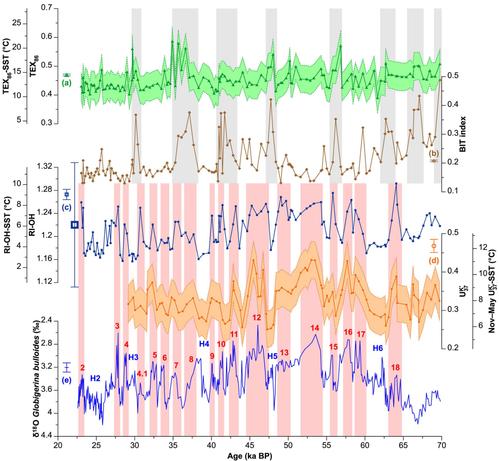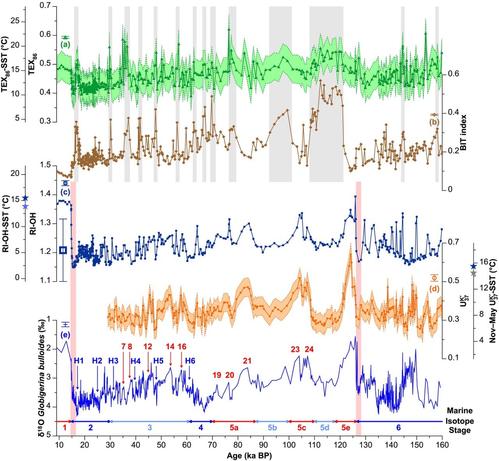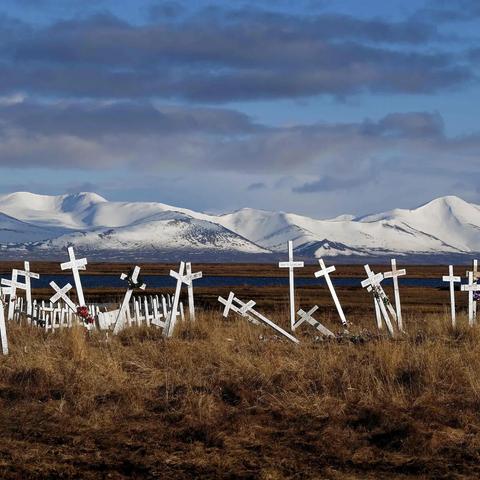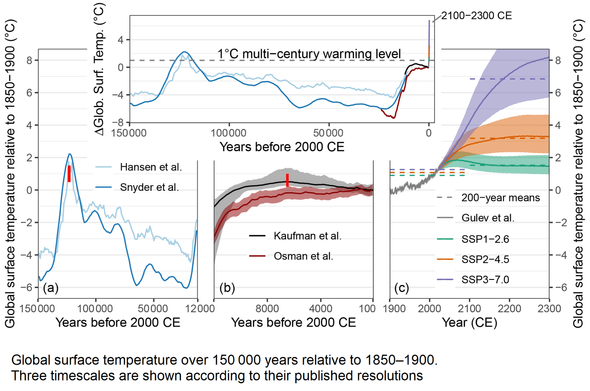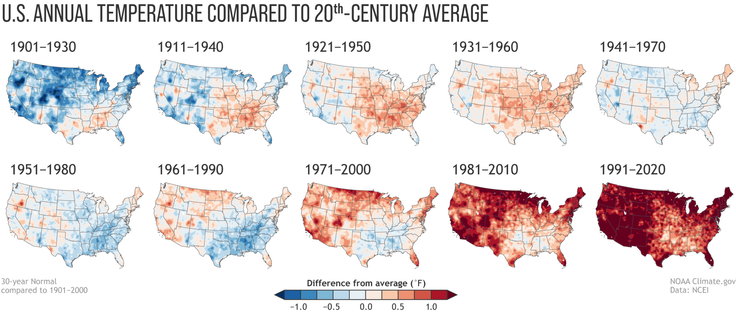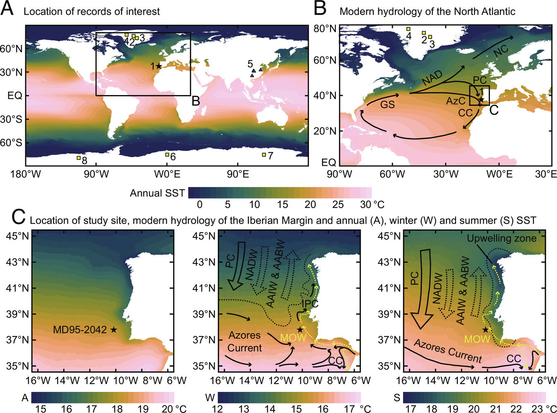On this #InternationalWomensDay, let me highlight two #WomenInSTEM.
First, Amy Cromartie, who leads the following @EuroGeosciences #preprint:
https://egusphere.copernicus.org/preprints/2025/egusphere-2025-526/
Second, Devika Varma, who recently defended her #PhD #thesis. Her PhD work at @NIOZnieuws aimed to investigate #paleotemperature indicators based on #archaeal hydroxylated #tetraether #lipids (OH-isoGDGTs):
https://www.nioz.nl/en/news/investigating-paleotemperature-proxies-based-on-archaeal-hydroxylated-tetraether-lipids
#IWD #IWD25 #IWD2025
#Science #ScienceMastodon #AcademicMastodon
#GDGTs #brGDGTs #isoGDGTs
(1/3)
#paleotemperature
On this #InternationalDayOfWomenAndGirlsInScience, here is a great story presented in two papers led by a #WomanInScience (Jingjing Guo) and last authored by another #WomanInScience (Francien Peterse).
#Scientific #publication #1: https://doi.org/10.5194/cp-21-343-2025
Scientific publication #2: https://doi.org/10.1016/j.orggeochem.2025.104947
#Science
#ScienceMastodon
#AcademicMastodon
#PaleoClimate
#PaleoHydrology
#EastAsianMonsoon
#PaleoTemperature
#OrganicGeochemistry
#GDGTs #brGDGTs
#ClimateProxies #Loess
#IDWGS #IDWGS2025
My co-authored #scientific #publication by De Jonge et al. (2024) G³ just got cited in this new #paper with a multi-#biomarker paleo-sequence:
https://doi.org/10.1016/j.gloplacha.2024.104620
Also featuring a novel (OH-)isoGDGT-based #paleotemperature #ClimateProxy!
Disclaimer: I am not a co-author and I was not a reviewer either.
#Science
#ScienceMastodon #AcademicMastodon
#PaleoClimate #SeaTemperature #SeaSurfaceTemperature #SST
#Biomarkers #Alkenones #Diols #LongChainDiols #GDGTs #isoGDGTs
https://mastodon.world/@nina_davtian/113364845688520878
I am honored to co-author the new #scientific #publication first-authored by Petter Hällberg! This time, it is the use of #levoglucosan rather than #GDGTs—as #paleohydrology rather than #paleotemperature #ClimateProxies this time!—which granted me this #collaboration and co-authorship!
https://doi.org/10.1016/j.quascirev.2024.108948
More information in the following thread: 👇🏻 (1/6)
#Science
#ScienceMastodon #AcademicMastodon
#Paper #OpenAccess #OpenAccessWeek #OpenAccessWeek24 #OpenAccessWeek2024
#isoGDGTs #brGDGTs
A lot of times, when I discuss #marine #paleotemperature or #ocean #FutureTemperatures, I use the #Mediterranean as a reference for what those temperatures mean for things like plankton, deep water generation, or mineral preference.
Every year, that reference is getting warmer, and now it hit a new record.
Unlike #TEX86, another #GDGT-based #paleotemperature #ClimateProxy named the #Ring #Index of hydroxylated tetraethers (RI-OH) behaves as an #SST proxy despite the terrigenous #inputs.
This #place too deserves a #thread about my related #PhD #research #publication in #Paleoceanography and #Paleoclimatology:
https://doi.org/10.1029/2018PA003452 (1/5)
#Science #ScienceMastodon #Paper
#PaleoClimate #PaleoClimates
#ClimateChange #ClimateChanges #AbruptClimateChange
#SeaSurfaceTemperature
#MediterraneanSea
Two #basic #things to #know for #GDGT #lovers like me:
- These #nerdy #membrane-spanning #lipids are #ubiquitous in the #environment
- #GDGTs may have #multiple and #mixed #sources
If like a younger me* you apply #TEX86 in (#paleo)prodelta #deposits, be prepared to obtain #spooky #results from this #GDGT-based #paleotemperature #ClimateProxy!
#Links to the related #research #publication and #source #data in my auto-reply 👇🏻
*Me when I was a #PhDStudent
Past And Future Warming – Direct Comparison On Multi-Century Timescales
--
https://doi.org/10.5194/cp-18-911-2022 <-- shared paper / technical note
--
#GIS #spatial #mapping #anthropogenic #climatechange #humanimpact #global #temperature #millenia #centuries #model #modeling #spatialanalysis #IPCC #globalmeantemperatures #paleotemperature #reconstruction #warming #impacts #multicentury #greenhousegasemissions #emissions #holocene #spatiotemporal #variability
New first-authored #scientific #publication in @PNASNews with Edouard Bard (Collège de France and CEREGE)!
We revisit the #thermal bipolar seesaw using #PaleoTemperature records from the Iberian Margin!
#Science #Paper
#PaleoClimate #PaleoClimates
#ClimateChange #ClimateChanges #AbruptClimateChange
#SeaSurfaceTemperature #SST
#ClimateProxies #GDGTs #RIOH #Alkenones #UK37
#NorthAtlantic #AtlanticOcean #Atlantic #Ocean
#AtlanticMeridionalOverturningCirculation #AMOC
https://doi.org/10.1073/pnas.2209558120 (1/20)
There was a zombie climate denier chart going around in German social media these days. A temperature anomaly chart from Greenland's Summit ice core, range 7000 years ago to 1850 or thereabouts.
From the comments by NON-deniers I gathered that many of us have not much understanding of how global mean temperature (anomaly) is calculated and modelled as reconstruction from
*latitudinal* or regional or local
proxies like ice cores, ocean or lake sediments, treerings, stalagmites or whathaveyou.
Ideally, a point in Greenland weighs as much in calculating global mean annual temperature as a point in Iran or one in the Southern Ocean. Same goes for temperature reconstruction models.
Except those are even trickier, as you can imagine. Because finding so many proxies ...
And then bear in mind how vast the space is that is covered by oceans which don't have much, and if, very slow temperature variations. That's why we often read the phrase "Europe (or some other region) warms twice as fast as the rest of the world". In our suicidal experiment, land simply warms faster than oceans. That's all. (Almost.)
Long story short. Maybe, your mind works like mine and needs to see latitudinal temperature bands of the whole globe, and the paleo reconstruction of temperature variations of the latitude bands.
So here goes. A globe with 2021 absolute annual temperature. To the left are the northern hemisphere bands in 30º steps from the pole to equator, and their ºC variation of the past from 11100 BP to present. ("Present" is defined as 1950; "BP" means Before Present)
To the right, the Southern steps from equator to pole.
The next two images show annual temperature of 1950 and the same holocene temperature as the first picture, Northern and Southern latitude bands.
Data is from Kaufmann et al 2020. You can access the dataset here https://www.ncei.noaa.gov/access/paleo-search/study/29712
or as csv https://www.ncei.noaa.gov/pub/data/paleo/reconstructions/kaufman2020/temp12k_allmethods_percentiles.csv
The globe picture is from here https://climatereanalyzer.org/reanalysis/monthly_maps/
Hashtags:
#Paleoclimate #ClimateDenier #PaleoTemperature #Holocene


